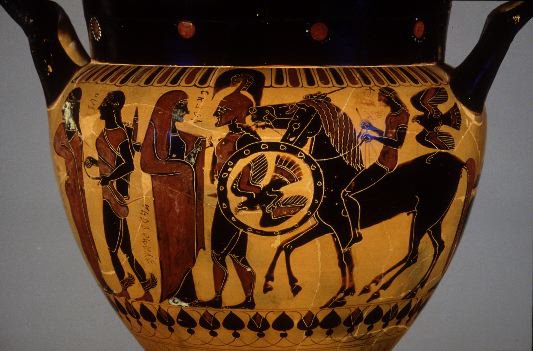
Ilankai Tamil Sangam
Association of Tamils of Sri Lanka in the USA
Published by Sangam.org
by A Concerned Tamil, September 16, 2008
|
American films portrayed the “Red Indian” (the Native American) as savage and cruel, concealing the fact that a friendly and trusting people had been cruelly set upon, and were putting up a desperate struggle for their land and survival. And so it will be with Sinhalese accounts of the Tamil struggle for equality: another Dutugemmunu victory, with the cowardly, “terrorist” Tamils surrendering to the brave Sinhalese army. |
 |
Andromache and Hector |
One of the remarkable features of The Iliad (among the most famous of Western, classic, texts) is that, though written by a Greek (or Greeks), for Greeks, and celebrating a Greek triumph, the courage and other positive qualities exemplified by the enemy, the Trojans, are recognized and admired. Indeed, Trojan Hector emerges as one the finest heroes of the Iliad. Nor is sympathy withheld from the defeated: for example, the portrayal of Hector’s wife, her husband killed, her son murdered; yesterday a queen, today a slave.
Such honesty and generosity are alien to most Sinhalese, and what we have is triumphalism and vulgar jeering: “The tiger has become a pussy cat.” “The rats are cornered in their hole”, and so on. The fact is that from the mid-1980s about twenty to thirty thousand Tigers (according to the Sinhalese army commander, the number is now only 4,000) male and female, took on an army numbering about 150,000. What is more, this state-supported army, having international recognition, purchases weaponry on the open, competitive, market. The Sinhalese state had and has at its disposal deadly weapons of modern warfare - jet planes and helicopters. The Tigers have not had even have ground-to-air systems to neutralize these planes and helicopters that have wreaked a destruction that was both indiscriminate and terrible. Last but not least, unlike the Taliban who operate from mountainous territory (ideally suited for guerilla warfare) the Tigers fight on flat terrain.
Tamil opinion of, and attitude to, the Tigers varies but, whatever this opinion, the brilliance of some of the campaigns the LTTE has waged, the audacity of the raids and operations they have mounted and, above all, the incredible courage and self-sacrifice of the Tiger rank-and-file, must be admitted - even by those who are against the Tigers. (Heroism displayed by the enemy is denigrated as “fanaticism”, the result of “brainwashing”.)
History, it is said, is written by the victors, but I hope some individuals and groups with knowledge will write detailed and interesting military histories of the struggle waged by the LTTE. Given Sinhalese contempt; given the attempt to humiliate the Tamils; given their effort to force the acceptance of a subservient position on the Tamils, such books will help future generations of Tamils to know, and so to preserve, something of inner pride and dignity.
In the absence of such works, Tamil children may have only the Sinhalese version of the conflict. For example, where the war between Dutugemmunu and Elara is concerned, we have only the Sinhalese version. In the absence of a counter-narrative, Tamil children in Sinhalese-controlled areas also read this “story” based on what is found in The Mahavamsa. (I recall as a child having to read this Sinhalese-Buddhist version in a prescribed school text-book, and the feelings of embarrassment and shame it created in me.) Imperial history and stories portrayed the British as patriotic and heroic, generous and essentially decent, if not noble, while the “natives” were projected as weak, cowardly and treacherous. American films portrayed the “Red Indian” (the Native American) as savage and cruel, concealing the fact that a friendly and trusting people had been cruelly set upon, and were putting up a desperate struggle for their land and survival. And so it will be with Sinhalese accounts of the Tamil struggle for equality: another Dutugemmunu victory, with the cowardly, “terrorist” Tamils surrendering to the brave Sinhalese army.
If we ourselves do not record this aspect (the military struggle), future generations of Tamils (not to mention the world at large) will have only the Sinhalese version of the armed conflict. Real defeat is when a group comes to accept (mentally and emotionally) the inferiority portrayed and projected by the other. It is the most effective of defeats. Future Tamil generations must be provided with a history, a memory, that instills self-respect and confidence, if not pride, so that they will be like the phoenix, the mythical bird that, after being burnt, rose up from the ashes with renewed youth.
There are already several political analyses and histories, and what I urge is the writing of the military struggle: factually, with detail (and illustrative maps where necessary) and interestingly narrated. Such accounts should be available, most importantly, within the Island, both in Tamil and English.
Needless to say, history must not become hagiography. Exaggeration, apart from being falsification, creates doubt and disbelief, and thus damages, rather than helps, the case being made. Besides, where the Tamil armed struggle is concerned, exaggeration is not needed! Mistakes and failures can be acknowledged - and still the wonder will emerge that so few fought so many and for so long – brilliantly and bravely.
I hope it is clear that the concern here is not for the LTTE but for future generations of Tamil children, and the strengthening of their self-respect, dignity and pride. Those of a certain age will know that, before 1980, the image of the Tamil was one of timidity (if not cowardice) and meekness. This image must not be allowed to be brought back. Future generations of Tamils must be strengthened so that they do not give up and accept the “image” and third-class status that chauvinist Sinhalese attempt to project.
© 1996-2025 Ilankai Tamil Sangam, USA, Inc.